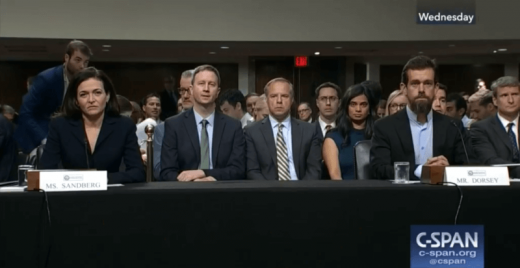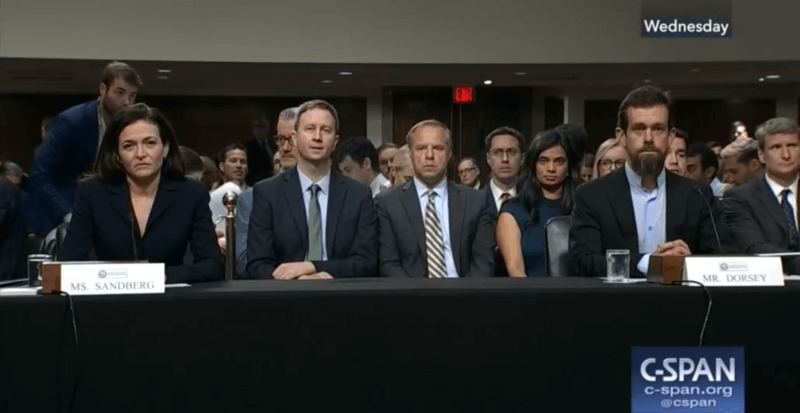Facebook, Twitter grilled by Senate committee; Dorsey says company may label bots
While Facebook’s Sheryl Sandberg and Twitter’s Jack Dorsey had very little new information to share, that could be both a blessing or a curse for advertisers.
Facebook COO Sheryl Sandberg and Twitter CEO Jack Dorsey on Wednesday appeared before a Senate committee to face questions over their companies’ failure to keep bad actors off of their platforms, allegations of bias against conservative content, and what they’re in fact doing to address lawmakers’ concerns. Google, which was also asked to testify, chose not to attend.
While most of the morning was spent with Senators reiterating the same concerns Facebook CEO Mark Zuckerberg faced when he testified before Congress in April, there were a few new pieces of information, including Dorsey’s claim that Twitter may begin labeling bots in the near future. Here’s the breakdown.
The Senate’s biggest concerns
Members of the committee wanted to know what Facebook and Twitter were doing to stop the spread of misinformation campaigns on their platforms. There were questions about whether or not Facebook and Twitter believed their users had a right to their data. Committee members said they wanted more transparency around user data — and not just how much each platform had, but how much the data is worth to the companies.
Republican members of the committee repeated their charges that Twitter was suppressing conservative views, and members from both parties wanted to know more about Facebook’s protocol for removing content that violated the company’s community standards. Republican Sen. Tom Cotton asked Dorsey if Twitter was an American company (the subtext being whether or not Dorsey considered Twitter a patriotic company), while Democratic Sen. Joe Manchin asked Sandberg if she thought Facebook was responsible for the illegal opioid sales happening on its platform.
And while there were few issues lawmakers agreed on, Google not showing up for the hearing had most every member of the intelligence committee visibly perturbed.
“I’m deeply disappointed that Google, one of the most influential digital platforms in the world, chose not to send its own top corporate leadership to engage this committee,” Sen. Mark Warner, who serves as the vice chairman of the committee, said in a released statement that echoed concerns of many fellow committee members, “because I know our members have a series of difficult questions about structural vulnerabilities on a number of Google’s platforms that we’ll need answers for — from Google search which continues to have problems surfacing absurd conspiracies to YouTube, where Russian-backed disinformation agents promoted hundreds of divisive videos, to Gmail where state-sponsored operatives attempted countless hacking attempts.”
In fact, Republican Sen. James Risch told both Sandberg and Dorsey that there were people who would, “… love to help you run things through a regulatory process.”
Things we learned
Among the topics covered during the three-hour hearing, Dorsey’s comment that Twitter was considering a label to identify accounts managed by bots was something he has not said publicly before.
“We can certainly label and add context to accounts that come through our API. What becomes a lot trickier is where automation is scripting our website to look like a human actor,” he said. “So as far as we can label and identify these automations, we can label them and I think that is useful context. It’s an idea we have been considering over the past several months. It’s really a question of implementation, but we are interested in it and we are going to do something along those lines.”
Dorsey said the company has built better tools, created stronger policies and developed new partnerships to help fight bad actors aiming to take advantage of the app. He said Twitter is now removing more than 200 percent more spammy accounts than it was last year and now taking down approximately 8 to 9 million spammy accounts a week: both figures released in June when it published an overview of its current safety initiatives.
Following the hearing, Dorsey did share one non-vital, but interesting piece of information — his heart rate during the proceedings.
Heart rate during a Senate and House hearing pic.twitter.com/LipSHa3xIi
— jack (@jack) September 5, 2018
In response to questions around election integrity and what the platforms are doing to fight bad actors, Facebook and Twitter both offered the same responses they have been giving throughout the year through updates on their company blogs and Twitter feeds.
Sandberg owned up to Zuckerberg’s original statement that Facebook had been too slow to identify foreign influence on Facebook during the 2016 U.S. elections. She said since then the company has doubled its safety and security teams — now at more than 20,000 staff. She repeated the heavy investments Facebook is making in its machine learning systems to battle fake news and that, right now, 85 percent of the content taken down for violating community guidelines is identified and removed by automated systems.
The Facebook COO also recapped the new feature that shows all ads a Page is running and the new verification process for political advertisers.
“The investments we are making are yielding results,” said Sandberg after addressing the company’s most recent security move to take down 32 Pages that were part of a coordinated misinformation campaign originating in Iran.
Both Dorsey and Sandberg also confirmed they were working with outside organizations to fight foreign influence on the platforms and said that they shared what they knew about coordinated misinformation campaigns with other social networks.
“This is not something we want to compete on,” said Dorsey.
What all this means for marketers
At the end of the day, neither Facebook nor Twitter confirmed any new policies or actions around data privacy protections or security efforts that haven’t already been released. This doesn’t offer much in the way of either company’s continued efforts to improve the health of their platform — which could be both a blessing or curse for advertisers.
On the surface, even with the limited third-party data and heightened transparency around ads, Facebook’s ad targeting capabilities are still a goldmine for brands. The question then becomes how long will the gold rush last? A recent Pew report found that 26 percent of Facebook users had deleted their app since March, and 42 percent had taken a break from the platform for several weeks or more. More than half had adjusted their privacy settings.
As both Facebook and Twitter struggle to overcome the crisis of platforms plagued with bad actors, advertisers will ultimately be the arbitrators of whether or not the companies — and the audiences they offer — are worth their advertising investments.
Marketing Land – Internet Marketing News, Strategies & Tips
(28)




